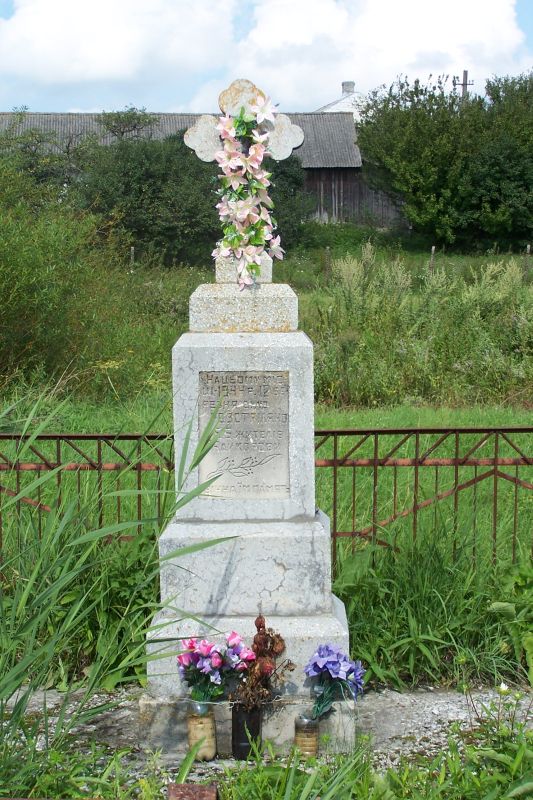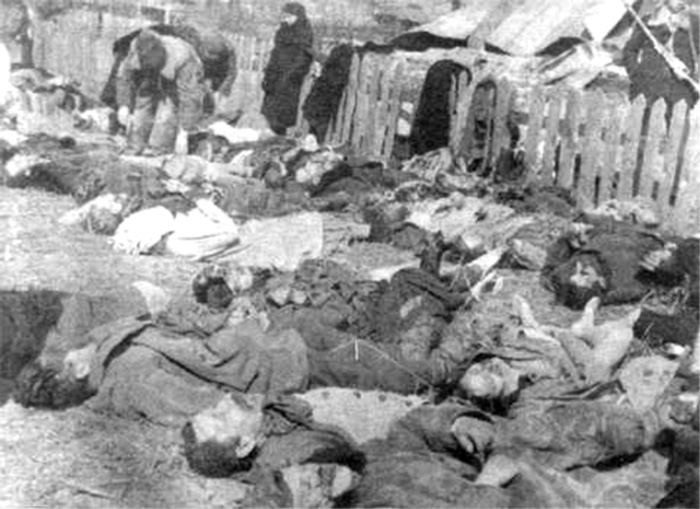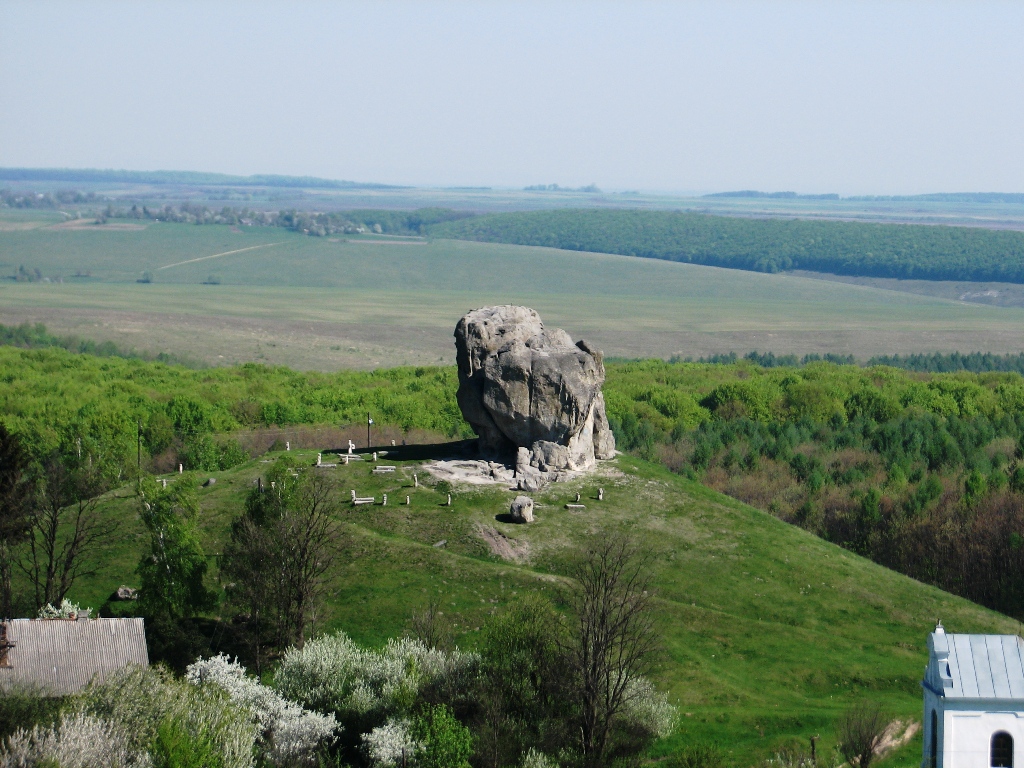|
Palikrowy2
Palykorovy ( ua, Паликорови) is a village (''selo'') in Zolochiv Raion, Lviv Oblast, in western Ukraine. It belongs to Pidkamin settlement hromada, one of the hromadas of Ukraine. Palykorovy was founded in 1501. The name literally "burn the cows". From 1918 to 1939 the village was known by its Polish spelling "Palikrowy" as it was then located in the Tarnopol Voivodeship in Poland. History The village was founded in 1501. On March 12, 1944 an act of ethnic cleansing took place allegedly by SS-Galizien, SVK ("Self-defence"), and Ukrainian Insurgent Army on Poles in the village of Palykorovy. 365 Poles were executed. Palikrowy was an ethnically mixed village, with 70% Polish population. In 1944, the population was about 1880, with about 360 houses. On 12 March 1944, village was surrounded by soldiers of SS-Galizien and local SVK and UIA units. Action was coordinated with an attack in nearby Pidkamin including the monastery in Pidkamin, where some of inhabitants ... [...More Info...] [...Related Items...] OR: [Wikipedia] [Google] [Baidu] |
Palikrowy2
Palykorovy ( ua, Паликорови) is a village (''selo'') in Zolochiv Raion, Lviv Oblast, in western Ukraine. It belongs to Pidkamin settlement hromada, one of the hromadas of Ukraine. Palykorovy was founded in 1501. The name literally "burn the cows". From 1918 to 1939 the village was known by its Polish spelling "Palikrowy" as it was then located in the Tarnopol Voivodeship in Poland. History The village was founded in 1501. On March 12, 1944 an act of ethnic cleansing took place allegedly by SS-Galizien, SVK ("Self-defence"), and Ukrainian Insurgent Army on Poles in the village of Palykorovy. 365 Poles were executed. Palikrowy was an ethnically mixed village, with 70% Polish population. In 1944, the population was about 1880, with about 360 houses. On 12 March 1944, village was surrounded by soldiers of SS-Galizien and local SVK and UIA units. Action was coordinated with an attack in nearby Pidkamin including the monastery in Pidkamin, where some of inhabitants ... [...More Info...] [...Related Items...] OR: [Wikipedia] [Google] [Baidu] |
Countries Of The World
The following is a list providing an overview of sovereign states around the world with information on their status and recognition of their sovereignty. The 206 listed states can be divided into three categories based on membership within the United Nations System: 193 member states of the United Nations, UN member states, 2 United Nations General Assembly observers#Present non-member observers, UN General Assembly non-member observer states, and 11 other states. The ''sovereignty dispute'' column indicates states having undisputed sovereignty (188 states, of which there are 187 UN member states and 1 UN General Assembly non-member observer state), states having disputed sovereignty (16 states, of which there are 6 UN member states, 1 UN General Assembly non-member observer state, and 9 de facto states), and states having a political status of the Cook Islands and Niue, special political status (2 states, both in associated state, free association with New Zealand). Compi ... [...More Info...] [...Related Items...] OR: [Wikipedia] [Google] [Baidu] |
Pidkamin Massacre
The Pidkamin massacre or the Podkamień massacre of 12 March 1944 was the massacre of Polish civilians committed by the Ukrainian Insurgent Army (UPA) under the command of Maksym Skorupsky (Maks), in cooperation with a unit of the 14th SS-Volunteer Division "Galician".Mikolaj Falkowski"Podkamień. Perła Kresów. Miejsce pamięci ofiar UPA." Official webpage of the Polish Radio./ref> The victims were ethnic Polish residents of the Eastern Galician village of Podkamień in the occupied Second Polish Republic's Tarnopol Voivodeship (now Pidkamin, Zolochiv Raion, Ukraine). During the war the area was administratively part of the Nazi German ''Reichskommissariat Ukraine'' (now Ternopil Oblast). Estimates of victims include 150,Grzegorz Motyka, Ukraińska Partyzantka 1942–1960, Warszawa 2006, p. 182, 385 more than 250 List of Poles murdered by Ukrainian nationalists in Podkamien and neighboring villages {{DEFAULTSORT:Pidkamin Massacre 1944 in Poland Mass murder in 1944 Mass ... [...More Info...] [...Related Items...] OR: [Wikipedia] [Google] [Baidu] |
Chodaczkow Wielki Massacre
Velykyi Khodachkiv ( uk, Великий Ходачків, pl, Chodaczków Wielki) is a selo in Ternopil Raion, Ternopil Oblast, Ukraine. It lies on the banks of the Rudka river, on the rail line from Ternopil to Rohatyn. Velykyi Khodachkiv belongs to Pidhorodne rural hromada, one of the hromadas of Ukraine. The population is 1394 people (2003 census). The first mentions of the village date back to 1758. On 16 April 1944 the village was almost totally razed. Of the 710 houses in the village only 30 were left standing. From 1944-46, 210 ethnic Ukrainian families from prewar Poland were resettled there. History The village was the location of the Chodaczków Wielki massacre during World War II. Chodaczków Wielki was an ethnically Polish village before the Soviet invasion of Poland. According to Polish historian, Grzegorz Hryciuk, on 16 April 1944 the village was destroyed by the Ukrainian 4th SS Police Regiment then subordinated to SS-Galizien. The estimates of victims range fr ... [...More Info...] [...Related Items...] OR: [Wikipedia] [Google] [Baidu] |
Huta Pieniacka Massacre
The Huta Pieniacka massacre was a massacre of the Polish inhabitants of the village Huta Pieniacka, located in modern-day Ukraine, which took place on February 28, 1944. Estimates of the number of victims range from 500, to 1,200.Pure Soldiers Or Sinister Legion Polish and Ukrainian historians disagree over the responsibility for the Huta Pienacka massacre. According to the Polish , the action was committed by the 14th subunit of the [...More Info...] [...Related Items...] OR: [Wikipedia] [Google] [Baidu] |
Massacres Of Poles In Volhynia
The massacres of Poles in Volhynia and Eastern Galicia ( pl, rzeź wołyńska, lit=Volhynian slaughter; uk, Волинська трагедія, lit=Volyn tragedy, translit=Volynska trahediia), were carried out in German-occupied Poland by the Ukrainian Insurgent Army, or the UPA, with the support of parts of the local Ukrainian population against the Polish minority in Volhynia, Eastern Galicia, parts of Polesia and Lublin region from 1943 to 1945. The peak of the massacres took place in July and August 1943. Most of the victims were women and children. Many of the Polish victims regardless of age or gender were tortured before being killed; some of the methods included rape, dismemberment or immolation, among others. The UPA's actions resulted in between 50,000 and 100,000 deaths. According to Timothy Snyder, the ethnic cleansing was a Ukrainian attempt to prevent the post-war Polish state from asserting its sovereignty over Ukrainian-majority areas that had been part of th ... [...More Info...] [...Related Items...] OR: [Wikipedia] [Google] [Baidu] |
Historiography Of The Volyn Tragedy
This article presents the historiography of the Volyn tragedy as presented by historians in Poland and Ukraine after World War II. The Massacres of Poles in Volhynia were part of the ethnic cleansing operation in the Polish province of Eastern Galicia and Volhynia (now in western Ukraine) that took place beginning in March 1943 and lasted until the end of 1944. According to political scientist Nathaniel Copsey, research into this event was quite partisan until 2009 (with some exceptions) and dominated by Polish researchers, some of whom lived there at the time or are descended from those who did. The most thorough is the work of Ewa and Władysław Siemaszko, the result of years of research conducted with the goal of demonstrating that the Poles were victims of genocide. Nonetheless, the 45 years of state censorship resulted in an excessive supply of works described as "heavy in narrative", "light in analysis" and "inherently - though perhaps unconsciously - biased against Ukrainians. ... [...More Info...] [...Related Items...] OR: [Wikipedia] [Google] [Baidu] |
Brody Raion
Brody Raion ( uk, Бродівський район, translit: ''Brodivs’kyi raion'') was a raion (district) of Lviv Oblast (region) of Western Ukraine. Its administrative center was Brody. The raion was abolished on 18 July 2020 as part of the administrative reform of Ukraine, which reduced the number of raions of Lviv Oblast to seven. The area of Brody Raion was merged into Zolochiv Raion. The last estimate of the raion population was . The raion was located at the easternmost portion of Lviv Oblast bordering with Rivne and Ternopil Oblasts to its east, Volyn Oblast to the north, Radekhiv Raion to the northwest, Busk Raion to the west, and Zolochiv Raion to the southwest. Historically, the district (county) became known as border checkpoint between the Austria-Hungary Empire and the Russian Empire. As a county (powiat) it was established in 1866 as part of the Kingdom of Galicia and Lodomeria. After World War I, the area became part of the Second Polish Republic within the T ... [...More Info...] [...Related Items...] OR: [Wikipedia] [Google] [Baidu] |
Machine Gun
A machine gun is a fully automatic, rifled autoloading firearm designed for sustained direct fire with rifle cartridges. Other automatic firearms such as automatic shotguns and automatic rifles (including assault rifles and battle rifles) are typically designed more for firing short bursts rather than continuous firepower, and are not considered true machine guns. As a class of military kinetic projectile weapon, machine guns are designed to be mainly used as infantry support weapons and generally used when attached to a bipod or tripod, a fixed mount or a heavy weapons platform for stability against recoils. Many machine guns also use belt feeding and open bolt operation, features not normally found on other infantry firearms. Machine guns can be further categorized as light machine guns, medium machine guns, heavy machine guns, general purpose machine guns and squad automatic weapons. Similar automatic firearms of caliber or more are classified as autocannons, rat ... [...More Info...] [...Related Items...] OR: [Wikipedia] [Google] [Baidu] |
Pidkamin
Pidkamin ( uk, Підкамінь, pl, Podkamień) is an urban-type settlement in Zolochiv Raion (district), Lviv oblast in Ukraine. It is located near the administrative border of three oblasts, Lviv, Rivne, and Ternopil. Pidkamin hosts the administration of Pidkamin settlement hromada, one of the hromadas of Ukraine. Population: Description The village takes its name (translatable into English as "below the rock") from an inselberg called the "Devil's Rock", which is located on an adjacent hill. Pidkamin became known for a Dominican monastery. It was established by twelve monks from a monastery established by Saint Hyacinth in Kyiv who were forced to flee from the city when it was ravaged by Mongols (in 1240). Prior Urban and 12 monks were martyred by Tatars in 1245. In the second half of the 15th century wasteland around the place where the monastery had been, was in possession of nobleman Petrus Cebrovscii who founded the town. With his assistance on the mountain was ... [...More Info...] [...Related Items...] OR: [Wikipedia] [Google] [Baidu] |
Ukrainian Insurgent Army
The Ukrainian Insurgent Army ( uk, Українська повстанська армія, УПА, translit=Ukrayins'ka povstans'ka armiia, abbreviated UPA) was a Ukrainian nationalist paramilitary and later partisan formation. During World War II, it was engaged in guerrilla warfare against the Soviet Union, the Polish Underground State, Communist Poland, and Nazi Germany. It was established by the Organization of Ukrainian Nationalists. The insurgent army arose out of separate militant formations of the Organization of Ukrainian Nationalists—Bandera faction (the OUN-B), other militant national-patriotic formations, some former defectors of the Ukrainian Auxiliary Police, mobilization of local populations and others.Vedeneyev, D. Military Field Gendarmerie – special body of the Ukrainian Insurgent Army'. "Voyenna Istoriya" magazine. 2002. The political leadership of the army belonged to the OUN-B. It was the primary perpetrator of the ethnic cleansing of Poles in Volhy ... [...More Info...] [...Related Items...] OR: [Wikipedia] [Google] [Baidu] |
14th Waffen Grenadier Division Of The SS Galicia (1st Ukrainian)
The 14th Waffen Grenadier Division of the SS (1st Galician) (german: 14. Waffen-Grenadier-Division der SS alizische Nr. 1}; uk, 14а Гренадерська Дивізія СС (1а галицька)), known as the 14th SS-Volunteer Division "Galicia" (german: 14. SS-Freiwilligen Division "Galizien", uk, 14а Добровільна Дивізія СС "Галичина") prior to 1944, was a World War II German military formation made up predominantly of military volunteers with a Ukrainian ethnic background from the area of Galicia,Williamson Gordon, SS Hitler's Instrument of Terror, Amber books 1994, pp.123–4 later also with some Slovaks. Formed in 1943, it was largely destroyed in the battle of Brody, reformed, and saw action in Slovakia, Yugoslavia, and Austria before being renamed the first division of the Ukrainian National Army and surrendering to the Western Allies by 10 May 1945. Background After World War I and the dissolution of Austria-Hungary, the territor ... [...More Info...] [...Related Items...] OR: [Wikipedia] [Google] [Baidu] |








